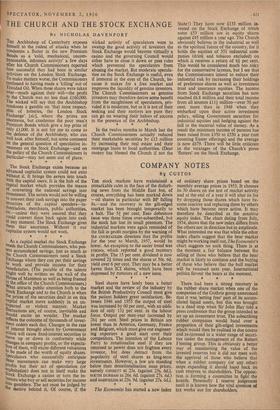COMPANY NOTES
By CUSTOS THE stock markets have maintained a remarkable calm in the face of the disfurb- ing news from the Middle East but, of course, everything has been marked down —oil shares in particular with BP falling 8s.—and the recovery in the gilt-edged market has been brought temporarily to a halt. The 54 per cent. Esso debenture issue was three times over-subscribed, but the stock has lost its small premium. The industrial markets were again reminded of the fall in profit margins by the warning of the COURTAULDS directors that the profits for the year to March, 1957, would be lower. An exception to the easier trend was FISONS, which reported a good recovery in profits. The 15 per cent. dividend is now covered 24 times and the shares at 50s. 6d. yield over 6 per cent. They may be a better haven than ICI shares, which have been depressed by rumours of a new issue.
* * *
Steel shares have lately been a better market and the review of the industry by the British Productivity Council must give the patient holders great satisfaction. Be- tween 1946 and 1955 the output of steel was increased by 60 per cent., with an addi- tion of only 134 per cent. in the labour force. Output per man-year increased by 264 per cent. Steel prices in Britain are lower than in America, Germany, France and Belgium, which must give our engineer- ing exporters a good start over their competitors. The intention of the Labour Party to renationalise steel if they are returned to power does not frighten every investor, but does detract from the popularity of steel shares as long-term investments. However, a few are standing below their denationalisation issue prices, namely coNsarr at 23s. (against 25s. 6d.), SOUTH DURHAM at 26s. 6d. (against 27s. 6d.) and HADFIELDS at 23s. 9d. (against 27s. 6d.).
* * *
The Economist has started a new index of ordinary share prices based on the monthly average prices in 1953. It chooses its 50 shares on the test of market activity and at the end of a year it will alter its list by dropping those shares which have be- come inactive and replacing them by others which have become more active. It may therefore be described as the sensitive .equity index. The chart dating from July, 1954, shows that the new index differs from the others not in direction but in amplitude. What interested me was that while the other index charts suggest that the bear market might be working itself out, The Economist's chart suggests no such thing. There is at the moment a fair balance between the selling of those who believe that the bear market is likely to continue and the buying of those who believe that the bull market will be resumed next year. International politics favour the bears at the moment.
There had been a strong recovery in the rubber share market when one of the companies of the Guthrie group announced that it was 'setting free' part of its accum- ulated liquid assets, but this was brought to a dead stop when Sir John Hay told a press conference that the group intended to set up an investment trust. The subscribing rubber companies would hand over a proportion of their gilt-edged investments which would then be realised in due course and re-invested in a wider range of securi- ties under the management of the Robert Fleming group. This is obviously a better way of maintaining the value of the invested reserves but it did not meet with the approval of those who believe that when a rubber company (or any other) stops expanding it should hand back its cash reserves to shareholders. The opposi- tion is forming a committee to fight the boards. Personally I reserve judgement until it is known how the vital question of tax works out for shareholders.


































 Previous page
Previous page